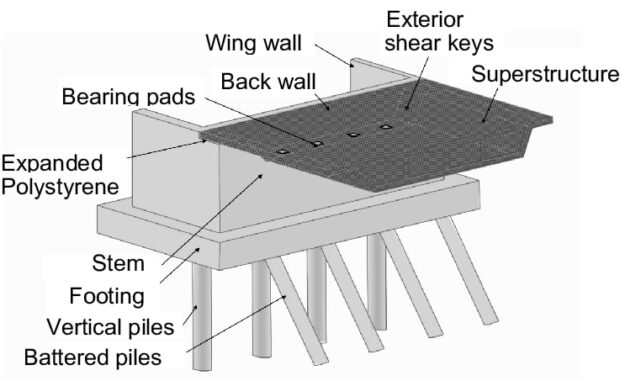What is a Bridge Abutment?
A bridge abutment is an essential component of a bridge structure, it serves the purpose of connecting the bridge to approaching roadways and provides support to the structure vertically by distributing the weight of the bridge.
Abutments are provided at the end of the bridge span. It helps in transmitting the weight of the bridge superstructure to the ground. Longer-span bridges will have several abutments at defined intervals, which provide support throughout the bridge by equal weight distribution.
The type of abutment is chosen based on the following factors,
- Available spaces
- Geological factors of the bridge site
- Project budget
Also read – Pros and Cons of Floating Building | Top 10 Floating Buildings in the World
Components of Bridge Abutment

1. Bridge Seat
The bridge seat is a horizontal shelf located at the top of the abutment which supports the bridge deck. These will hold onto the span bridge on the embankment.
2. Wing Wall
Wing wall is only included in the abutment when the bridge is connected to an embankment. This component of abutment is a short retaining wall, that prevents soil erosion.
3. Back Wall
Back walls are only included in embankment walls, which are built vertically at the ends of the bridge span. these components support the expansion joints of the bridge span/deck.
4. Abutment Pile
Abutment pile is vertical structure that connects the abutment foundation to the bridge seat. Abutment pile length depends on the height of the bridge and the depth of the obstacle (stream, river, and canal)
5. Abutment Footing
Abutment footing is also called a bridge foundation. It connects the piles to the ground and it is wider and heavier which helps prevent sinking of the abutment into the ground.
Also Read – 25+ Indian Compound wall Designs for your Dream House
Functions Of Abutments
- Load transmission from the bridge deck to its foundation.
- Abutment helps maintain the equilibrium in the bridge by resisting vertical and horizontal loads.
- Provides vertical support to bridge deck.
- Abutment helps in resisting or transmitting self-weight, lateral loads (such as earth pressure), and wind loads.
Also Read – Different Types of Pavement |Difference between flexible and rigid pavement
Types of Abutments
- Gravity Abutments
- U-shaped Abutments
- Spill-through Abutments
- Cantilever Wall Abutment
- Mechanically Stabilized Earth (MSE)
- Full Height Abutments
- Stub Abutments
- Semi-stub Abutment
- Counterfort Abutment
1. Gravity Abutments
Gravity abutments use their dead weight to resist horizontal earth and water pressure. Foundations of these types of abutments are broad and solid.
Gravity abutment structures are placed directly on the ground and it sustained by the earth’s gravitational pull.
2. U-shaped Abutments
U-shaped Abutments have wing walls perpendicular to the face which act as counter forts. These types of abutments are very stable.
The wing walls of the abutment are at a 90-degree angle (perpendicular) to the seat of the bridge. This type of Abutment has a pair of piles, which are at a distance equal to the width of the bridges.
U-shaped Abutments are constructed with reinforced cement concrete. At the bottom, both the piles of the abutment are connected using a foundation. Both the piles have a common foot.
3. Spill-through Abutments
These abutments are short and stubby which holds the bridge at various points throughout its span. In spill-through abutments, the bridge deck is supported y short walls or columns as there are no wing walls or back walls to maintain the embankment in place.
Spill-through Abutments are designed to reduce the amount of soil pressure on the abutment by installing large voids in the stem.
4. Cantilever Wall Abutment
Cantilever wall abutments serve two major purposes one is to retain soil behind the bridge’s ends, and the other supports the bridge superstructure.
5. Mechanically Stabilized Earth (MSE)
MSE is defined as Mechanically Stabilized Earth, these are true abutments means there are no piles in these types of abutments. These are more economical than other types of abutments.
These abutments are mainly made using precast concrete panels, metallic soil reinforcing strips, and backfill to support the superstructure and support the roadway approach roadway embankment.
6. Full Height Abutments
Full-height abutments are tall and erected to the lower level roadway and it is designed to support the entire embankment.
These types of abutments are costly and mainly built in densely populated urban and metropolitan areas where structure depth is crucial.
7. Stub Abutments
These are short abutments placed on top of embankments or on the slope of an embankment, these are supported by piles. Stub abutments are not noticeable from the ground surface.
8. Semi-stub Abutment
The height of the Semi-stub abutment lies between full full-height and stub-abutment heights. Unlike others, stub abutments are constructed on or near the top of the embankment and full-height abutments are constructed at the bottom.
Semi-sub abutments are built between the embankments’ top and bottom. These are known as Semi-Stub abutments because they are larger than stub abutments but shorter than full-height abutments.
9. Counterfort Abutment
It is similar to the counterfort retaining wall. In counterfort abutment, a thin wall called counterfort connects the breast wall to the footing.
These counterfort abutments are built at spaces of regular intervals so that the breast wall is designed as a supported slab rather than as a cantilever.
Also read – Cantilever Bridge – Types, Advantages, Disadvantages & Applications


